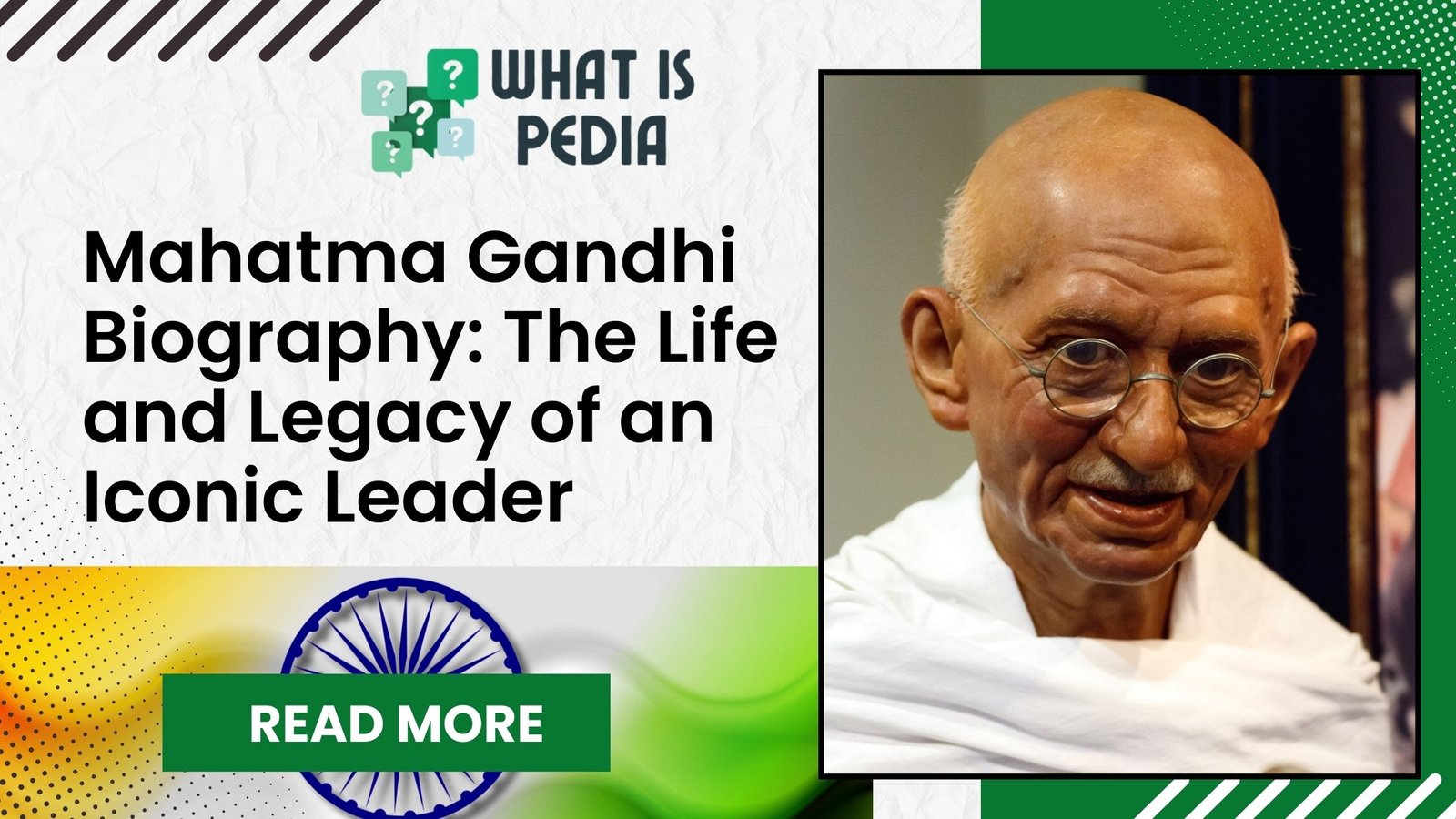1. Introduction
Mahatma Gandhi, widely regarded as one of the most iconic Indian leaders, played a pivotal role in India’s struggle for independence. His unique approach to resistance, rooted in non-violence (Ahimsa) and Satyagraha (truth force), inspired millions worldwide. Known as Mohandas Karamchand Gandhi, he earned the title Mahatma, meaning ‘Great Soul,’ for his unwavering commitment to peace and justice.
Understanding the biography of Mahatma Gandhi provides insight into how an ordinary boy from Porbandar became a global symbol of non-violent resistance. His ideologies not only shaped India’s freedom struggle but also influenced civil rights movements worldwide. This blog delves into the life of Mohandas Gandhi, exploring his early years, activism, philosophies, and enduring legacy.
2. Early Life and Education
Birth and Childhood
Mahatma Gandhi was born as Mohandas Karamchand Gandhi on October 2, 1869, in Porbandar, a coastal town in present-day Gujarat, India. His father, Karamchand Gandhi, served as the Diwan (Chief Minister) of Porbandar, while his mother, Putlibai, was a devout and religious woman.
Growing up in a conservative Hindu household, Gandhi’s values were deeply rooted in truth, compassion, and non-violence. He was greatly influenced by his mother’s piety and Jainism’s emphasis on Ahimsa, which later became the cornerstone of his philosophy.
Education
Mohandas Gandhi completed his early education in Rajkot. Though an average student, he exhibited honesty and discipline from a young age. In 1888, at the age of 18, Gandhi traveled to London to study law at the Inner Temple. This journey marked his first significant exposure to Western culture.
During his stay in England, Gandhi adopted a vegetarian lifestyle and explored various religious texts, including the Bhagavad Gita, the Bible, and the works of Leo Tolstoy. These readings shaped his ethical and philosophical outlook, laying the foundation for his future ideologies.
3. Life in South Africa
First Steps into Activism
After completing his law degree, Mahatma Gandhi returned to India but struggled to establish a legal career. In 1893, he accepted a one-year contract to work for an Indian firm in South Africa, a decision that changed the course of his life.
In South Africa, Gandhi faced blatant racial discrimination. The infamous incident at Pietermaritzburg railway station, where he was thrown out of a first-class compartment despite having a valid ticket, ignited his resolve to fight injustice. This experience marked the beginning of his transformation from a lawyer to a social activist.
To combat discrimination against Indians in South Africa, Gandhi established the Natal Indian Congress in 1894. This organization aimed to unite the Indian community and advocate for their civil rights.
Satyagraha Movement
It was in South Africa that Mahatma Gandhi developed the concept of Satyagraha, meaning “truth force” or “soul force.” This philosophy promoted non-violent resistance as a powerful tool against oppression.
Gandhi led several successful campaigns in South Africa, including protests against the discriminatory Asiatic Registration Act (1906). His commitment to non-violence and civil disobedience laid the groundwork for his future struggles in India.
4. Return to India and Early Struggles
Arrival in India (1915)
After two decades in South Africa, Mahatma Gandhi returned to India in 1915 as a respected leader. He was welcomed by Gopal Krishna Gokhale, a prominent leader of the Indian National Congress, who became his mentor.
Gandhi spent the initial years traveling across India, understanding the plight of common people. He soon realized that the country was grappling with poverty, injustice, and colonial exploitation.
Initial Movements
- Champaran Satyagraha (1917):
- Gandhi led a non-violent protest against the exploitation of indigo farmers by British landlords in Champaran, Bihar.
- Kheda Satyagraha (1918):
- In Kheda, Gujarat, Gandhi supported farmers who demanded tax relief after a failed harvest.
- Ahmedabad Mill Strike (1918):
- Gandhi advocated for better wages for textile mill workers in Ahmedabad, using hunger strikes as a form of protest.
These early successes established Mahatma Gandhi as a prominent leader in India’s fight for independence.
5. Major Freedom Movements
Non-Cooperation Movement (1920–1922)
The Non-Cooperation Movement marked Mahatma Gandhi’s first large-scale nationwide campaign against British rule. It called for the boycott of British goods, schools, and institutions.
Gandhi emphasized the importance of Swadeshi, urging Indians to wear khadi (homespun cloth) and support local industries. The movement gained massive support but was suspended in 1922 after the Chauri Chaura incident, where violence erupted.
Civil Disobedience Movement (1930–1934)
In 1930, Mahatma Gandhi launched the Civil Disobedience Movement, with the famous Salt March (Dandi March) as its centerpiece. Gandhi marched 240 miles from Sabarmati Ashram to Dandi, breaking the British salt law as an act of symbolic defiance.
This movement saw widespread participation, including women and students, making Gandhi an international figure of resistance.
Round Table Conferences
Mahatma Gandhi participated in the Second Round Table Conference in 1931, representing the Indian National Congress. However, the conference failed to achieve significant progress toward Indian self-rule.
Quit India Movement (1942)
During World War II, Gandhi launched the Quit India Movement, demanding the immediate withdrawal of the British from India. The slogan “Do or Die” became the rallying cry of the movement.
The British government responded with mass arrests, including Gandhi himself. Despite the repression, the movement galvanized Indians toward the final push for independence.
6. Gandhi’s Philosophy and Ideology
Non-Violence (Ahimsa)
At the heart of Mahatma Gandhi’s philosophy was Ahimsa, or non-violence. He believed that true strength lay in the ability to resist injustice without resorting to violence.
Gandhi’s commitment to Ahimsa was influenced by Jainism, Hinduism, and the writings of Leo Tolstoy. He practiced non-violence not only in political struggles but also in personal conduct.
Satyagraha
Satyagraha, meaning “truth force”, was Gandhi’s most powerful tool against oppression. It involved peaceful protests, civil disobedience, and non-cooperation with unjust laws.
Gandhi believed that Satyagraha could transform both the oppressor and the oppressed by appealing to their conscience.
Simple Living and Self-Reliance
Mahatma Gandhi promoted simple living and self-reliance as a way to achieve economic independence. He encouraged Indians to spin their own cloth using the Charkha and boycott foreign goods.
The Swadeshi movement, which emphasized local production and consumption, became a powerful economic and political statement.
7. Role in Indian Independence
Negotiations with the British
Mahatma Gandhi played a crucial role in negotiating with the British for India’s independence. Key events included:
- Gandhi-Irwin Pact (1931): A truce between Gandhi and the British government, leading to the suspension of the Civil Disobedience Movement.
- Cripps Mission (1942): A failed attempt by the British to secure Indian cooperation during World War II.
Partition and Independence (1947)
While Mahatma Gandhi celebrated India’s independence on August 15, 1947, he was deeply saddened by the partition of India and Pakistan. He worked tirelessly to quell communal violence during this period.
8. Assassination and Legacy
Assassination
On January 30, 1948, Mahatma Gandhi was assassinated by Nathuram Godse, a Hindu extremist who opposed Gandhi’s efforts for Hindu-Muslim unity. His death plunged the nation into mourning, and tributes poured in from around the world.
Legacy
Mahatma Gandhi’s legacy extends far beyond India’s independence. His principles of non-violence, truth, and justice inspired global leaders like Martin Luther King Jr., Nelson Mandela, and Cesar Chavez.
Even today, Gandhi’s ideals guide movements for civil rights, peace, and social justice worldwide.
9. Conclusion
Mahatma Gandhi remains a towering figure in world history, symbolizing the power of non-violent resistance against oppression. His contributions to India’s independence and his unwavering commitment to truth and justice continue to inspire generations.
As we reflect on Gandhi’s life, we are reminded that true change begins with courage, compassion, and a commitment to doing what is right.
To explore the life of another remarkable Indian leader, read the Biography of Sarojini Naidu.
10. FAQ Section
1. Who was Mahatma Gandhi?
Mahatma Gandhi, born Mohandas Karamchand Gandhi, was a prominent Indian leader who led India’s non-violent struggle for independence from British rule.
2. Why is Gandhi called the Father of the Nation?
Mahatma Gandhi is called the Father of the Nation because of his pivotal role in India’s independence movement through non-violent resistance.
3. What was the Salt March?
The Salt March, led by Mahatma Gandhi in 1930, was a 240-mile protest against the British salt tax, symbolizing civil disobedience.
4. How did Gandhi die?
Mahatma Gandhi was assassinated by Nathuram Godse on January 30, 1948, during a prayer meeting in New Delhi.







